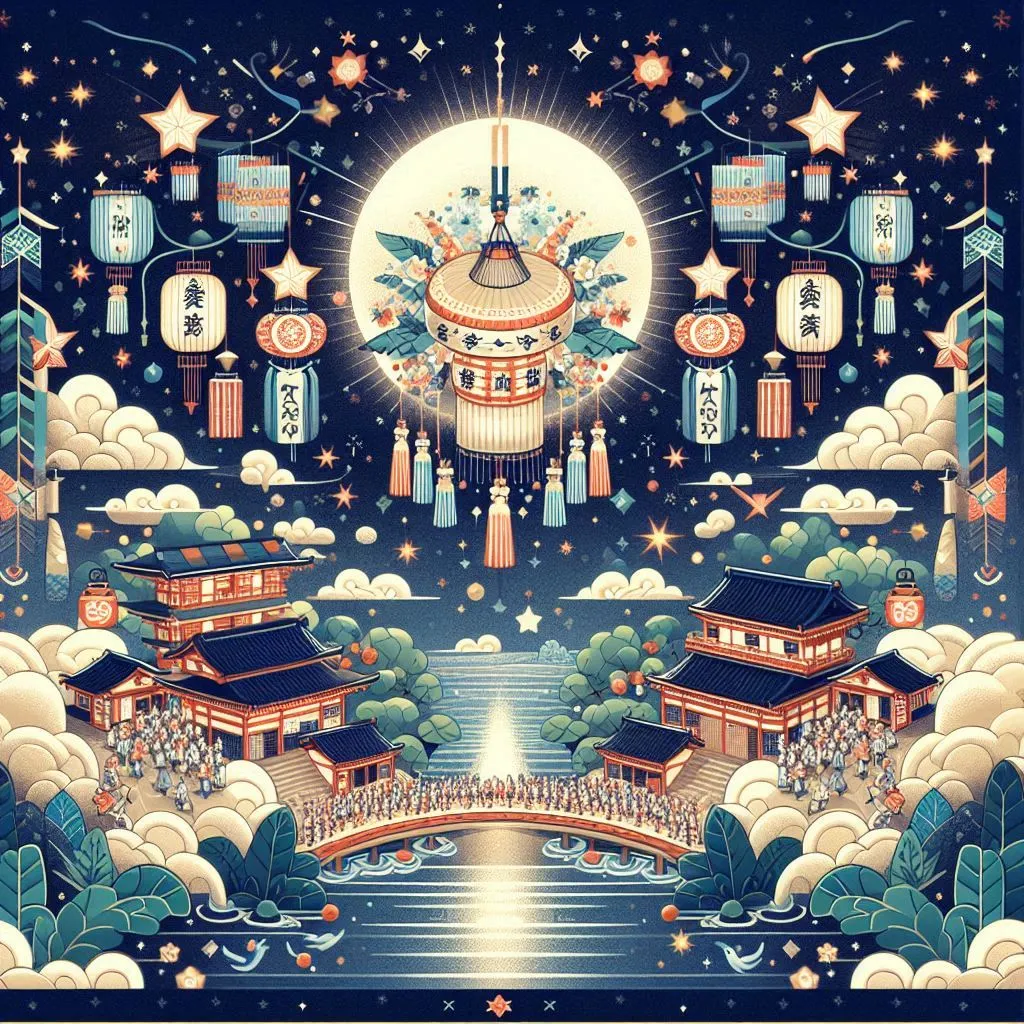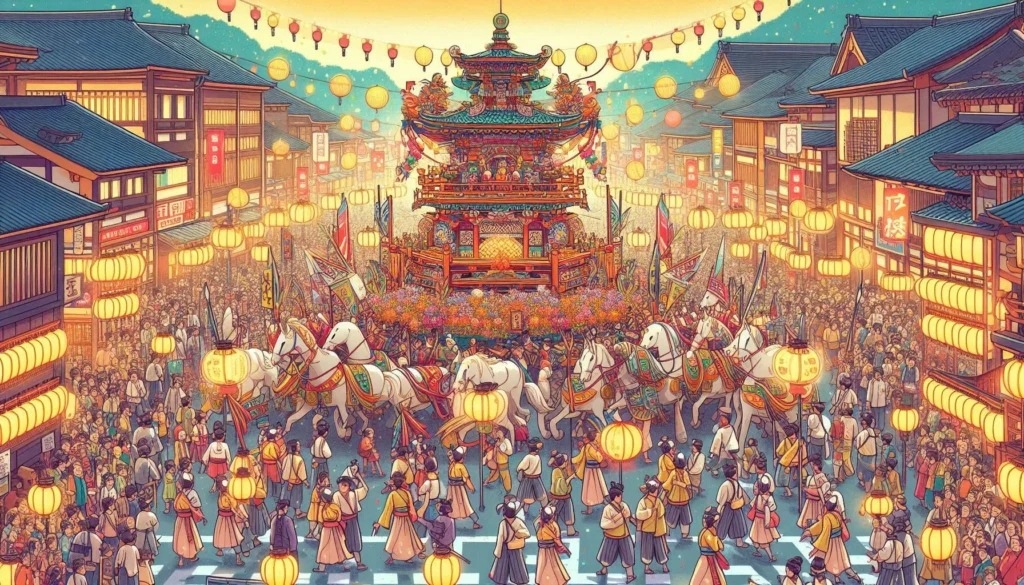
The Haunting Reality Behind Japan’s Star-Crossed Lovers Festival
In the bustling, neon-lit cities of Japan, the Tanabata Festival brings a touch of ancient magic every year. Thousands of people gather to celebrate the celestial reunion of two star-crossed lovers, weaving their wishes into vibrant strips of paper and hanging them on bamboo trees. But beneath the colorful façade and joyful celebrations, lies a tale tinged with melancholy and unfulfilled dreams. This is the haunting reality of Tanabata, a festival that, despite its surface allure, holds a deep, bittersweet sentiment.
The Origins of Tanabata: A Tale of Love and Separation
The origins of Tanabata are rooted in a Chinese legend, which tells the story of Princess Orihime (the star Vega) and Hikoboshi (the star Altair). Orihime, a talented weaver, and Hikoboshi, a cowherd, fell deeply in love after meeting each other across the Milky Way. However, their love led them to neglect their duties, incurring the wrath of Tentei, the Sky King and Orihime’s father. As punishment, the lovers were separated by the vast expanse of the Milky Way, allowed to meet only once a year on the seventh day of the seventh lunar month.
This poignant story of love and separation is the backbone of Tanabata, a festival that not only celebrates love but also underscores the pain of unfulfilled desires and longing. It is this underlying sense of melancholy that makes Tanabata a festival of haunting beauty.
The Tradition of Wishing: Hope Amidst Despair
One of the most iconic aspects of Tanabata is the tradition of writing wishes on colorful strips of paper called tanzaku, and hanging them on bamboo branches. People wish for everything from academic success to personal happiness, hoping that their desires will reach the stars. The sight of these wish-laden trees is undeniably beautiful, but it also serves as a stark reminder of the many dreams and aspirations that remain unfulfilled.
Every year, millions of wishes are written and hung, yet how many of these dreams actually come true? The tanzaku fluttering in the wind symbolize both hope and despair, a visual representation of humanity’s ceaseless pursuit of happiness and the often elusive nature of our desires. The act of wishing during Tanabata is both a testament to human optimism and a silent acknowledgment of the many dreams that may never be realized.

Festivals and Celebrations: estivals and Celebrations
The modern celebrations of Tanabata are marked by elaborate parades, stunning decorations, and a plethora of cultural activities. Cities like Sendai and Hiratsuka become hubs of vibrant festivities, drawing tourists and locals alike. The streets are adorned with large, intricate paper decorations, and the air is filled with music, dance, and laughter.
However, amidst the celebration, the underlying sadness of Tanabata’s origin story can still be felt. The grand festivities seem almost like a distraction, a way to mask the deeper, more sorrowful essence of the festival. The joyous atmosphere contrasts sharply with the story of eternal separation, creating a bittersweet experience for those who delve into the festival’s true meaning.
Reflection and Acceptance: Finding Peace in Unfulfilled Dreams
Despite the melancholy undertones, Tanabata also offers a moment for reflection and acceptance. It reminds us that life is filled with both joy and sorrow, and that unfulfilled dreams are a natural part of the human experience. The festival encourages us to cherish the moments of happiness we do have and to find beauty even in the midst of sadness.
By acknowledging the pain of Orihime and Hikoboshi’s separation, we can find solace in our own unfulfilled dreams. The story teaches us that while not all dreams may come true, the act of hoping and wishing is valuable in itself. It is a reminder to continue striving for our desires, even when faced with obstacles, and to find peace in the journey rather than the destination.
Tanabata, also known as the Star Festival, is celebrated with various activities and traditions that make the festival unique and memorable. Here are some of the key practices and customs associated with Tanabata:
- Writing Wishes on Tanzaku: One of the most iconic traditions of Tanabata is writing wishes on small, colorful strips of paper called tanzaku. People write their hopes, dreams, and aspirations on these tanzaku and hang them on bamboo branches. The bamboo, adorned with these wishes, is often displayed in homes, schools, and public places.
- Decorating with Streamers and Ornaments: Besides tanzaku, bamboo branches are also decorated with other colorful ornaments such as paper streamers, origami cranes, and various paper crafts. These decorations are often elaborate and symbolize different aspects of good fortune and prosperity.
- Tanabata Festivals and Parades: Various cities and towns across Japan host Tanabata festivals, featuring parades, performances, and stalls selling food and souvenirs. Some of the most famous Tanabata festivals include the Sendai Tanabata Matsuri and the Hiratsuka Tanabata Festival, where the streets are beautifully decorated with large, intricate paper decorations.
- Cultural Performances: Tanabata celebrations often include traditional Japanese performances such as taiko drumming, dance shows, and music concerts. These performances add to the festive atmosphere and allow attendees to enjoy Japanese culture.
- Traditional Food: Festival-goers can enjoy a variety of traditional Japanese foods and street snacks during Tanabata. Popular treats include takoyaki (octopus balls), yakisoba (fried noodles), and kakigori (shaved ice with flavored syrup). These foods add to the celebratory ambiance and offer a taste of Japanese cuisine.
- Lanterns and Illuminations: In some regions, Tanabata celebrations feature lanterns and illuminations. These light displays often depict scenes from the Tanabata legend or other traditional motifs, creating a magical atmosphere as the lights twinkle in the night.
- Tanabata Poetry: Some people also write poems related to the Tanabata legend or their personal wishes and aspirations. These poems can be displayed alongside the tanzaku, adding a literary element to the celebration.
- Boat Launching Ceremonies: In certain areas, especially those near rivers or the sea, people participate in boat launching ceremonies where small boats made of paper or wood, often carrying tanzaku, are set afloat. This practice symbolizes sending wishes to the deities and is believed to bring good luck.
- Praying at Temples and Shrines: Many people visit temples and shrines during Tanabata to pray for their wishes to come true. Special ceremonies and rituals are often held to honor the deities associated with the festival and to seek their blessings.
- Educational Activities: Schools and community centers may organize educational activities related to Tanabata, such as storytelling sessions, art and craft workshops, and lectures on the festival’s history and cultural significance. These activities help to preserve and pass down the traditions of Tanabata to younger generations.
The Dual Nature of Tanabata
The melancholy of Tanabata lies in its dual nature – a celebration of love and a recognition of unfulfilled dreams. It is a festival that captures the essence of human longing and the beauty of hope amidst despair. As the tanzaku sway gently in the breeze, they tell a story of dreams both realized and deferred, reflecting the complex tapestry of life itself. Tanabata, with its haunting beauty, invites us to embrace our own bittersweet experiences, to find strength in our dreams, and to appreciate the fleeting moments of connection that make life truly magical.
Read more: Naadam: Mongolia’s Ancient Festival of Sports, Culture, and Heritage



